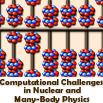Speaker
George Bertsch
Description
Nuclear structure physics has presented a fruitful testing
ground for quantum many-body theory since its beginnings
half a century ago. On the one hand, the observed phenomena
have given rise to models that have been invaluable to
interpret the underlying physics. On the other hand, the
quest to make a predictive theory has given strong impetus
to developing computational tools to solve the many-particle
Schroedinger equation. I will review some of these
theoretical highlights in nuclear structure, ranging from
the modeling and computation of few-body systems to the
many-particle finite systems represented by our heavy
nuclei. Among the models I discuss are the unitary-limit
fermionic Hamiltonian, the Nilsson model of nuclear
deformations, and the Richardson-Gaudin model of pairing.
Computational strategies that have been very successful in
different contexts are the Monte-Carlo methods, the
multi-configuration shell model, and the extensions of
mean-field
theory to restore broken symmetries.

